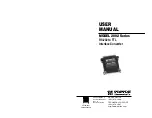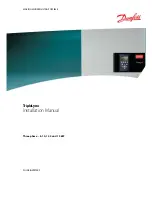
Electro-magnetic interference (EMI) and leakage currents
68
PRECAUTIONS FOR USE OF THE INVERTER
3.1
Electro-magnetic interference (EMI) and
leakage currents
3.1.1
Leakage currents and countermeasures
Capacitance exist between the inverter I/O cables, other cables and earth and in the motor, through which a leakage current
flows. Since its value depends on the static capacitances, carrier frequency, etc., low acoustic noise operation at the
increased carrier frequency of the inverter will increase the leakage current. Therefore, take the following precautions. Select
the earth leakage current breaker according to its rated sensitivity current, independently of the carrier frequency setting.
To-earth (ground) leakage currents
Leakage currents may flow not only into the power system of the inverter but also into the power systems through the earthing
(grounding) cable, etc. These leakage currents may operate earth leakage circuit breakers and earth leakage relays
unnecessarily.
Suppression technique
• If the carrier frequency setting is high, decrease the
Pr.72 PWM frequency selection
setting.
Note that motor noise increases. Selecting
Pr.240 Soft-PWM operation selection
makes the sound inoffensive.
• By using earth leakage circuit breakers designed to suppress harmonics and surge voltage in the power system of the
inverter and other devices, operation can be performed with the carrier frequency kept high (with low noise).
To-earth (ground) leakage currents
• Take caution as long wiring will increase the leakage current. Decreasing the carrier frequency of the inverter reduces the
leakage current.
• Increasing the motor capacity increases the leakage current.
Line-to-line leakage currents
Harmonics of leakage currents flowing in static capacitance between the inverter output cables may operate the external
thermal relay unnecessarily. When the wiring length is long (50 m or more) for small-capacity models (FR-F846-00170(7.5K)
or lower), the external thermal relay is likely to operate unnecessarily because the ratio of the leakage current to the rated
motor current increases.
Line-to-line leakage current example
Precautions
• Use
Pr.9 Electronic thermal O/L relay
.
• If the carrier frequency setting is high, decrease the
Pr.72 PWM frequency selection
setting.
Note that motor noise increases. Selecting
Pr.240 Soft-PWM operation selection
makes the sound inoffensive.
To ensure that the motor is protected against line-to-line leakage currents, it is recommended to use a temperature sensor
to directly detect motor temperature.
Motor
capacity (kW)
Rated motor
current (A)
Leakage current (mA)
Wiring length 50 m
Wiring length 100 m
0.4
1.8
620
1000
0.75
3.2
680
1060
1.5
5.8
740
1120
2.2
8.1
800
1180
3.7
12.8
880
1260
5.5
19.4
980
1360
7.5
25.6
1070
1450
• Motor: SF-JR 4P
• Carrier frequency: 14.5 kHz
• Cable: 2 mm
2
, 4 cores
• Cabtyre cable
Power
supply
Thermal relay
Line-to-line static
capacitance
MCCB
MC
Line-to-line leakage currents path
Motor
Inverter
M
















































